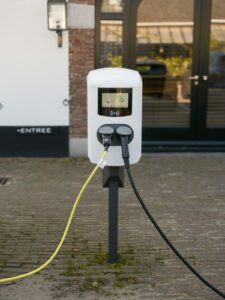
Home / EV Charging News / Vehicle-to-vehicle communication
Vehicle-to-vehicle communication: Electric vehicles could communicate with each other to optimize charging and reduce congestion at charging stations
As more people switch to electric vehicles (EVs) to reduce their carbon footprint, one of the challenges that arises is charging infrastructure. While the number of charging stations is increasing, the process of charging an EV can be slow, and there can be congestion at busy charging stations. However, new technology is emerging that could help optimize the charging process and reduce congestion: vehicle-to-vehicle (V2V) communication.
V2V communication is a technology that allows vehicles to share information with each other wirelessly. This technology can be used for a variety of purposes, including safety, traffic flow, and energy management.
V2V communication could be particularly useful for EVs. When an EV driver pulls up to a charging station, they may find that all of the charging spots are taken, and they must wait for a spot to open up. This can be frustrating and time-consuming, especially if the driver is in a hurry.
However, with V2V communication, EVs could communicate with each other to optimize the charging process. For example, if an EV is almost fully charged, it could communicate with other EVs in the area to let them know that it will be leaving the charging station soon. This would allow other EVs to wait for that spot instead of taking up a spot that they don’t need.
V2V communication has several benefits for EVs:
While V2V communication has many benefits, there are also some challenges that need to be addressed:
V2V communication is an emerging technology that could have significant benefits for EVs. By allowing EVs to communicate with each other, V2V communication can optimize the charging process, reduce congestion at charging stations, and save energy. However, there are also some challenges that need to be addressed, such as standardization, security, and cost. With the right solutions, V2V communication could be a game-changer for the future of EVs.
$2,890.00 Original price was: $2,890.00.$2,790.00Current price is: $2,790.00.
$3,950.00 Original price was: $3,950.00.$3,450.00Current price is: $3,450.00.
$1,650.00 Original price was: $1,650.00.$1,590.00Current price is: $1,590.00.
$2,290.00 Original price was: $2,290.00.$2,150.00Current price is: $2,150.00.
$1,290.00 Original price was: $1,290.00.$799.00Current price is: $799.00.

Your Power Management Partner for Over 25 Years Future Generations Depend on Our Decisions Today ™
2024 © All rights reserved by CyberSwitching